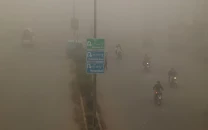Indus dolphin conservation: 3-pronged strategy suggested
‘Impose penalty on people who harm or kill a dolphin, check illegal fishing’.

Experts on Wednesday recommended revising fishing regulations, more research and cooperation among government departments and NGOs to conserve the Indus River Dolphin (bhullan).
The proposals came at the end of the two-day Indus River Dolphin Conservation Strategy and Action Plan 2012- 2022, organised by the World Wide Fund for Nature (WWF) and Wildlife Departments of three provinces.
According to a WWF-Pakistan Survey in July 2011, about 1,600 to 1,750 dolphins live along the 1,500-km stretch of River Indus. Of these 1,293 dolphins are found in the 200-km stretch between Guddu and Sukkur Barrages.
It is the second most endangered freshwater dolphin species in the world. The blind dolphins use echolocation, a sonar-like mechanism in which they utter a sound and then use the returning echoes to locate the position of the object generating the echoes.
Four groups comprising local and international conservationists and representatives of Irrigation and Wildlife Departments gave various suggestions about how to best preserve the dolphins. The recommendations were a follow up to lectures about the dolphins and existing laws on the first day of the workshop.
Ghulam Sarwar Gachal, head of zoology at the University of Sindh, stressed the need for research on fish resources and changing water levels in River Indus. It was also proposed that universities should lead with research while WWF, the Higher Education Commission (HEC) and the Pakistan Science Foundation should help with funds.
Other proposals included documenting the dolphins’ demographics and working with the Chinese Academy of Science, which is conducting research about the behaviour of river dolphins. Shadmeena Khanum, Himalayan Wildlife Foundation manager, said that Pakistan could either send samples to China or have their researchers come to Pakistan for research. She also suggested collaboration with institutes in India and Bangladesh.
Khanum also suggested that the WWF start an ‘eco-tourism package’ to educate people about the dolphins. “A percentage of the money generated can go towards conservation projects,” she said. She also recommended setting up a web portal to raise awareness and seek funds from around the world to conserve the dolphin.
Ghulam Muhammad Mehar, Sindh Fisheries Department director general, said that “overfishing, particularly fishing during night hours” needed to be checked to conserve Indus dolphins.
“Fishermen lay nets at night. Dolphins usually swim along with fish and thus get trapped in the nets. Some die as a result,” he said. He said that Fisheries and Wildlife departments need to work together to revise fishing regulations in order to make them more ‘dolphin friendly’. “Since licensing was introduced 18 months ago, more dolphins have died,” he said. Mehar said that local communities needed to be engaged in conservation efforts, “They sometimes hunt the dolphin for medicinal purposes,” he said, “Conservationists need to understand such issues.”
Dr Peter Thomas, the International and Policy Programme director of the Marine Mammal Commission, said that illegal fishing practices needed to be checked and penalties imposed on people who harmed or killed a dolphin.
Published in The Express Tribune, April 5th, 2012.



















COMMENTS
Comments are moderated and generally will be posted if they are on-topic and not abusive.
For more information, please see our Comments FAQ